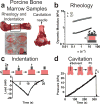Mechanics of intact bone marrow
- PMID: 26189198
- PMCID: PMC4554886
- DOI: 10.1016/j.jmbbm.2015.06.023
Mechanics of intact bone marrow
Abstract
The current knowledge of bone marrow mechanics is limited to its viscous properties, neglecting the elastic contribution of the extracellular matrix. To get a more complete view of the mechanics of marrow, we characterized intact yellow porcine bone marrow using three different, but complementary techniques: rheology, indentation, and cavitation. Our analysis shows that bone marrow is elastic, and has a large amount of intra- and inter-sample heterogeneity, with an effective Young׳s modulus ranging from 0.25 to 24.7 kPa at physiological temperature. Each testing method was consistent across matched tissue samples, and each provided unique benefits depending on user needs. We recommend bulk rheology to capture the effects of temperature on tissue elasticity and moduli, indentation for quantifying local tissue heterogeneity, and cavitation rheology for mitigating destructive sample preparation. We anticipate the knowledge of bone marrow elastic properties for building in vitro models will elucidate mechanisms involved in disease progression and regenerative medicine.
Keywords: Cavitation; Contact mechanics; Indentation; Rheology; Young׳s modulus.
Copyright © 2015 Elsevier Ltd. All rights reserved.
Figures




References
-
- Booth AJ, Hadley R, Cornett AM, Dreffs Aa, Matthes Sa, Tsui JL, Weiss K, Horowitz JC, Fiore VF, Barker TH, Moore BB, Martinez FJ, Niklason LE, White ES. Acellular normal and fibrotic human lung matrices as a culture system for in vitro investigation. Am J Respir Crit Care Med. 2012;186:866–876. doi: 10.1164/rccm.201204-0754OC. - DOI - PMC - PubMed
-
- Bryant J. On the mechanical function of marrow in long bones. Eng Med. 1988;17:55–58. - PubMed
-
- Bryant J, David T, Gaskell P, King S, Lond G. Rheology of bovine bone Marrow. Proc Instn Mech Engrs. 1988;203:71–75. - PubMed
-
- Chan EP, Smith EJ, Hayward RC, Crosby AJ. Surface Wrinkles for Smart Adhesion. Adv Mater. 2008;20:711–716. doi: 10.1002/adma.200701530. - DOI
Publication types
MeSH terms
Grants and funding
LinkOut - more resources
Full Text Sources
Other Literature Sources

